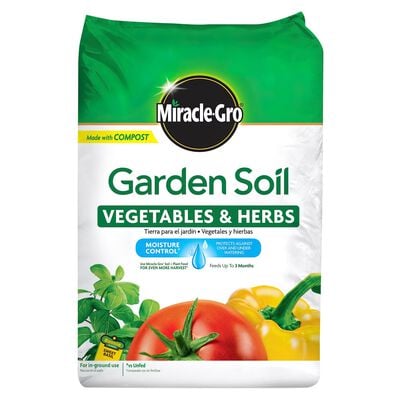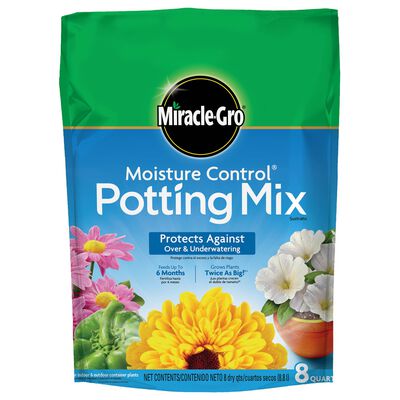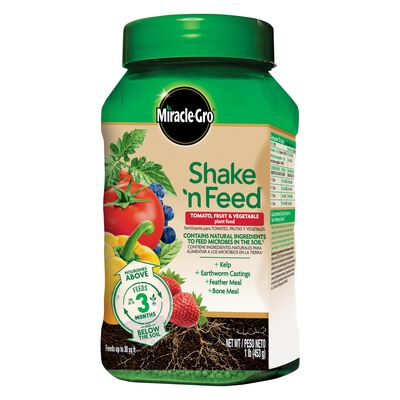
Growing Tomatoes
We teach you all about how to grow tomatoes.
- Plant tomatoes in spring for a summer harvest.
- Grow tomatoes in an area that gets 6-8 hours of sun.
- Improve soil nutrition and drainage by using a high-quality soil.
- Harvest tomatoes sooner by starting with young tomato plants.
- Plant deeply by burying 2/3 of the stem.
- Support tomatoes by giving them a stake or cage to climb as they grow.
- Keep soil moist by watering when the top 1 inch of soil is dry.
- Lay down 3 inches of mulch to help retain soil moisture and prevent weeds.
- Begin feeding tomato plants regularly with plant food one month after planting.
- Harvest when fruit reaches the color shown on the plant tag.
You don't need a big yard to grow tomatoes-you can even raise these tasty gems in pots. Admittedly, there are a few tricks to raising a bumper crop, like knowing how to plant tomatoes properly (the secret is to plant deeply). You also have to get the timing right. Tomatoes crave heat, and they're typically planted in spring for a summer crop. (Not sure which varieties of tomatoes to grow? Score expert advice with the Bonnie Plants® Tomato Chooser.)
Here are our top tips for growing tomatoes.

Prep
Choose a sunny spot, one that provides six to eight hours of sun. Aim for soil that is nutrient-rich and drains well. To achieve that balance of just-right drainage, plus add nutrients to the soil , mix 3 inches of aged compost-enriched Miracle-Gro® Performance Organics® All Purpose In-Ground Soil into the top 6 inches of soil in traditional in-ground gardens. If you're using pots, fill them with Miracle-Gro® Performance Organics® All Purpose Container Mix, which is lighter and fluffier than garden soil, and specially formulated for containers. When planting tomatoes in a raised bed, use a 50-50 blend of garden soil and potting mix, or 100 percent organic Miracle-Gro® Performance Organics® Raised Bed Mix. When growing tomatoes in pots, choose a container that is at least 18 to 24 inches wide.
Plant
Tomatoes are a warm-season crop that is usually planted during late spring and early summer, after all danger of frost is past. You can either start from seeds or buy young tomato plants like the strong, vigorous ones from Bonnie Plants®. Starting out with plants that are already well on their way to maturity is a great way to shorten the time you have to wait to harvest your first juicy, delicious tomato.
Growing tomatoes from seed requires sowing seeds indoors about six weeks before your region's average last frost date. Sow three tomato seeds per pot, in Miracle-Gro® Seed Starting Potting Mix. Seeds usually germinate in 5 to 10 days. When the first set of wavy-edged leaves appear, thin seedlings by snipping off all but the strongest one. If necessary, transplant seedlings into larger containers until they're ready to go into the garden.
Tuck tomato plants deeply into soil, burying two-thirds of the stem. Roots form along the buried stem, which results in a well-anchored plant with an extensive root system that will be better able to find water when summer heat and drought arrive. Leave two to three feet between plants, depending on variety. Be sure to water thoroughly after planting.
Support your tomato plants at planting time with a tall stake, trellis, or strong cage. Staking tomatoes keeps ripening fruits off the ground, where pests and diseases can be more likely to attack.

Grow
Water whenever the top inch of soil is dry. Tomato plants need more water as they increase in size and as summer heat arrives. Inconsistent watering, such as letting soil dry out severely (think wilted plants) before watering, can result in blossom end rot or cracked fruits.
Mulch around plants with 2 to 3 inches of Scotts® Nature Scapes® bagged mulch, straw, shredded leaves, pine straw, or untreated grass clippings. Mulch helps reduce weeds and keeps soil moist.
Tomato plants have big appetites and need a steady supply of plant food to grow their best. Miracle-Gro® Performance Organic® Edibles Plant Nutrition Granules feeds both your plants and the beneficial microbes in the soil (which help plants take up all the nutrition they need) for up to 6 weeks. A month after planting, mix this into soil around your tomato plants, following label instructions. Treating your plants to a combo of great soil and just the right nutrition is an effective way to put your garden on the road to amazing results.

Harvest
A ripe tomato should be fully colored and firm when you give it a gentle squeeze. Tomatoes will continue to ripen after picking, so you can start gathering the harvest a little early if pests like chipmunks or birds are nibbling your crop, or you are expecting a lot of rain (a sudden uptake of water by the plant can crack fruit and dilute the flavor).
Store nearly-ripe tomatoes in a warm spot, such as the kitchen counter or near a bright window. Once tomatoes ripen fully, store them in a cool, humid spot with good air movement. Avoid stashing ripe tomatoes in the fridge before you slice them, because temps below 55 °F break down flavor compounds.

Use
Tomatoes are extremely versatile in the kitchen. Eat them fresh as a side dish, sliced onto sandwiches or pizza, or in salads. Tomatoes are the key ingredient in salsa and spaghetti sauce, and they make a terrific soup. If you want to preserve the harvest, consider canning tomatoes, either whole or chopped, or turned into salsa or sauce. Ready to start planting and growing your own tomatoes? Click on any of the product links above for more information, to purchase the product online, or to find a retailer near you.


